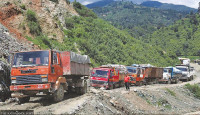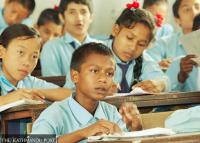Opinion
Face the future
The ongoing crises present a good opportunity for the rise of a new political force in Nepal
Krishna K Shrestha & Hemant R Ojha
The movement led by the Madhesis in the Tarai has crossed 100 days, and more than 50 people have already been killed in the protests. Yet, there is no amicable solution in sight. An increasing number of people are, for right reasons, deeply disappointed with the government and its ineffective response to the crisis, including the blockade. The hopes of the people have been dashed by negative politics. The ongoing political crises, however, are rooted in the failure of the political parties to lead the country.
Parties fail
All major political parties that have been active in Nepal after the restoration of democracy in 1990 have had serious problems. The largest party, Nepali Congress, which has ruled for over 80 percent of the time after 1990, has failed to provide clear leadership to the nation, let alone pave a pathway for development. Similarly, CPN-UML, the second largest party heading the current government, remains insensitive to the issues of inclusion. And despite the much applauded patriotic stance of the current PM KP Oli, the UML has failed to engage in mature diplomatic dealings with the two giant and strategically important neighbours, India and China. The UCPN (Maoist) party, despite ushering landmark political changes in the country in the last 15 years, has itself broken into half a dozen splinter groups, with the Prachanda-led faction struggling to regain its position. Meanwhile, the Tarai-based political parties are championing the cause of Madhesis. But as they have a narrow focus on issues related to regional identity, they have failed to present themselves as national-level political forces. The Rastriya Prajatantra Party-Nepal is obsessed with Panchayat legacies.
Over the years, ethnic politics has gained prominence in Nepali politics. Yet, it
has failed to unify political forces across the country. All of these suggest that Nepal is failing due to the lack of effective political leadership. This dire situation poses a serious question—does Nepal have a political party or a competent leadership that can live up to people’s aspirations by ameliorating heightened anxiety, hopelessness and anger among the public? The answer is a simple ‘No’. This critical juncture in Nepali politics and society, therefore, presents an opportunity to bring about transformative changes. There is the real need for a new or alternative political force radically different from the old ones in terms of values, visions, principles, procedures and organisation.
A to-do list
Political leadership is about competent, inspiring and strategic individuals (or a group of individuals) who are fit to and can indeed lead. A new leadership will have to emerge from the existing political parties, civil society movements, academia and the grassroots. Such a movement is unlikely to be similar to the Aam Aadmi Party in India. But it could be a regrouping of ‘good’ people who can lead. They can come from left, centre or the right. What such a new party essentially needs is an entirely new way of doing politics. We believe the new party should embrace at least seven critical principles.
First, the new leaders need to be able to demonstrate strong leadership to the people through the use of knowledge and evidence. The new force must express deep commitment to knowledge as an overarching principle of its political organisation.
Second, it needs to implement a truly inclusive and engaging model of politics. This can be done by ensuring the inclusion of diverse sections of society in senior party leadership positions. The new party should foster deliberative politics between the elected leaders and the people so as to ensure that legitimate voices are incorporated in every policy decision.
Third, the new leadership requires a strong sense of reflexivity with regard to recognising and acknowledging past failures and successes. They need to be committed to transformative politics for prosperity, consciously informed by their experience.
Fourth, the new force should balance the relations between India and China, not India or China. It should have demonstrated capacity to manage geopolitical relations and harness the strategic opportunity that India and China present to Nepal.
Fifth, the new party should promote strong internal democracy with open debating forums to make sure that every decision takes all existent facts, consequences and alternatives into account. This means, the new party should be taken as a learning organisation with capacity-building deeply embedded in it. Moreover, party cadres and leaders should have clear and well thought out plans to earn their livelihood and economic necessities to avoid corruptive practices. Transparent procedures are needed for allocating power and responsibilities among the leaders and cadres, while also putting mechanisms in place for expressing, deliberating and managing conflicts within the party.
Sixth, the political philosophy of the new party should be a blend of socialist and capitalist ideals. This involves promotion of liberal capitalist political economy with a vision to move towards socialist society. This also means embracing the public-private-community partnership model for development and prosperity. The opportunistic use of the neo-liberal market opportunity is critical to enhancing the livelihood of the poor.
Finally, the new political party should emphasise on the delivery of development goals through strategic planning and strict adherence to the rule of law. The leadership should demonstrate high moral, integrity, and accountability to the people. A detailed transformative development strategy document need to be presented in front of the wider public and should be amended every three years. Respect for authority vis-a-vis freedom of expression should be ensured to facilitate planned development and social change.
New power aspirants
In a nutshell, the ongoing crises present an opportunity for change in Nepal. The aforementioned points will provide some fundamental elements to conceptualise and operationalise a new political force. Of course, the existing political parties and leadership (and their astute supporters) would certainly claim to pursue all of the above principles and many more. But we cannot continue to tread this path any longer. We really need to look out for alternatives, and be willing to listen to others and be genuinely open to change.
Thus, we are glad to see people such as Baburam Bhattarai, Rabindra Mishra, Ujwal Thapa and others talk about the need for a new political force in Nepal. But it is not yet clear who is going to grab this unprecedented opportunity at this historical juncture of Nepali politics. Yet, we believe that a party is likely to succeed if it follows the above-mentioned principles.
Shrestha is senior lecturer and Ojha is research fellow at University of New South Wales, Australia




 21.12°C Kathmandu
21.12°C Kathmandu










